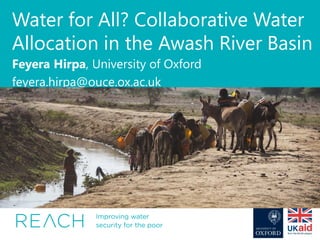
Water for All? Collaborative Water Allocation in the Awash River Basin
- 1. Water for All? Collaborative Water Allocation in the Awash River Basin Feyera Hirpa, University of Oxford feyera.hirpa@ouce.ox.ac.uk
- 2. REACH Water Security and Poverty Conference 27-29 March | Keble College, Oxford THE AWASH RIVER BASIN, ETHIOPIA • A major contributor to Ethiopia’s GDP – Agriculture, hydropower, livestock. Domestic and industrial water supply, ecosystem, commercial • Highly variable rainfall – Frequent occurrence of flood and drought – Low specific water yield (1/6th of Abbay; but with 15% more population density) • Multiple decision makes and stakeholders – Shared by 5 Regional States (112 woredas), and 2 Administrative City Councils
- 3. REACH Water Security and Poverty Conference 27-29 March | Keble College, Oxford DEMAND AND SUPPLY MISMATCH Supply Demand Demand – Agricultural – Livestock – Domestic and municipal – Industrial – Environmental flow Supply – Rainfall – River flow – Groundwater
- 4. REACH Water Security and Poverty Conference 27-29 March | Keble College, Oxford FUTURE FLOW WILL LIKELY DECREASE IN ETHIOPIA • High resolution climate simulations show the future streamflow will decrease in the Awash river basin • The high flows are expected to decrease, which may reduce the groundwater recharge rates • Low flows also will likely decrease, reducing water availability during the dry seasons.
- 5. REACH Water Security and Poverty Conference 27-29 March | Keble College, Oxford GROUNDWATER RESOURCES IN AWASH Six major aquifers in Awash basin Kebede et al., 2019 (in prep)
- 6. REACH Water Security and Poverty Conference 27-29 March | Keble College, Oxford SEDMENTATION IS FILLING THE RESERVIORS Sediment accumulation in Koka reservoir is decreasing the storage capacity by 13M m3/year. This may also be a problem for other dams.
- 7. REACH Water Security and Poverty Conference 27-29 March | Keble College, Oxford DECISION SUPPORT TOOLS FOR WATER RESOURCES PLANNING AND ALLOCATION Developed in collaboration with the Awash Basin Authority • Performs water allocation • Considers climate, policy and socio-economic changes WEAP model for the Awash basin Demand sites, catchments
- 8. REACH Water Security and Poverty Conference 27-29 March | Keble College, Oxford COLLABORATIVE ALLOCATION FOR EQUITABLE WATER ACCESS Stakeholders • Woredas (120) • Irrigated farmers (23) • Basin Authority – Hydrologists – Regulators
- 9. REACH Water Security and Poverty Conference 27-29 March | Keble College, Oxford COLLABORATIVE ALLOCATION FOR EQUITABLE WATER ACCESS • Only surface water supply • With surface and groundwater supply With no regulation/collaboration
- 10. REACH Water Security and Poverty Conference 27-29 March | Keble College, Oxford COLLABORATIVE ALLOCATION FOR EQUITABLE WATER ACCESS Surface and groundwater supply • No regulation/collaboration • Capped water use for irrigation
- 11. REACH Water Security and Poverty Conference 27-29 March | Keble College, Oxford COLLABORATIVE ALLOCATION FOR EQUITABLE WATER ACCESS • Surface water only • No regulation 1984 was extremely dry year • Groundwater and surface water • No regulation • Groundwater and surface water • Capped irrigation water use
- 12. REACH Water Security and Poverty Conference 27-29 March | Keble College, Oxford SUMMARY AND ONGOING WORK Summary • Water availability in the basin is changing • Sediment load is a major problem for water storage • Collaborative water allocation improves climate resilience in arid downstream Woredas Ongoing work • Add more regulations and policy options • Future population and economic growth • Link with groundwater model MODFLOW
- 13. Funded by: